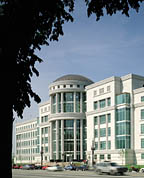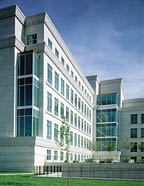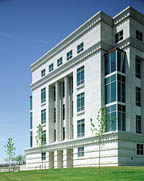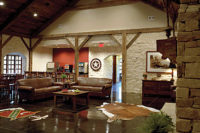

"The state recognized the value of using natural stone materials rather than brick or precast stone," said Moyes. "It was acknowledged that significant architecture for the state was supposed to last a long time and make a visually powerful statement, which could be done through the use of stone. We were grateful that the state saw the enhanced value that stone would bring to the building."
While presenting a design that included stone would benefit the architects in this design competition, doing so under cost would be difficult. "A stone building is obviously more expensive than one made of stucco or brick, but for us there was a value tradeoff - if we could find a way to put stone on the exterior, it would work," Moyes said.
The architects successfully secured the contract with their plan to clad the courthouse in limestone. "Our first goal was to build for a specified dollar amount," said Clifford Ham, vice president of HOK in San Francisco, CA. "We had a contract for a guaranteed maximum price, which was set from the early pre-schematic design competition entry we put together. From the beginning, we said it would be limestone; we just didn't know how we would do it."
The decision to use limestone for the courthouse came about for several reasons. "Our design goals were to accurately reflect the character of the state of Utah - especially Salt Lake City - to provide a building that is very efficient in terms of the use of space, and to create a timelessness that would be easy to maintain over time," Ham said. "Limestone had the right sort of relationship to other buildings in Salt Lake City, and we liked the idea of having a very traditional architectural appearance."
The limestone selected was Dove White from Valders Stone & Marble, Inc. in Valders, WI. "We wanted a heavy, roughened and rusticated base to the building," Ham said. "We also wanted to be able to carve into the stone, but durability was important. Limestone was a good choice for all of these reasons." The challenge was to find a particular type of limestone that was strong enough. Flexural strength and the ability to withstand deflection were important factors to consider, according to Ham.
The Dove White limestone used for the cladding of the Matheson Courthouse was not the architects' first choice. They initially looked at other types of limestone, however, none of them possessed the "structural integrity" the architects were seeking, according to Moyes. "We ended up choosing the Dove White because the stone is quite strong," he said. "It's one of the hardest, toughest, most durable stones that are out there. It is limestone with a performance status like granite."
The strength of the limestone made the process of panelization simpler, according to Moyes. "For paneling like this, the stone has to be quite strong," he said. "Either that, or the stone has to be quite thick." Using Dove White was the easiest and most cost-effective solution.
"We used a steel frame system to install the limestone cladding," said Ham. "The limestone was attached to the steel frame system with curve-cut edge anchors. Then it was bolted onto the building."
The result is a building that ties in with the surrounding architecture as well as the natural element of the earth, according to Ham. "The stone is very light in coloration with a hint of pink and gray that gives it a little bit of texture," he said. "There is also a certain variation from stone to stone that we liked, because it gives the building an honest sense of being assembled of blocks of stone." A total of 100,000 square feet of panels, measuring 2 x 3 feet each, were needed to complete the cladding.
The unfinished look of the stone added to its natural feel, according to Moyes. "The sawn finish we specified was a unique approach," he said. "This limestone has never been marketed unfinished before, but now it is sold with this rustic look."
Once the exterior was clad in stone, the architects moved to the inside. Despite the tight budget, there was room to use some additional natural stone on the interior. Tabasco travertine and black granite from Mexico were specified for the rotunda area. "The brownish chocolate color was a nice contrast to the light limestone exterior," Moyes said. "The stone floor was laid out in a 45-degree angle diamond pattern, which radiated out from a starburst pattern in the center of the main rotunda." The black granite was used around the edges of the flooring as well as in several medallions in combination with the travertine.
The success of this initial interior installation led to the incorporation of even more natural stone throughout the interior design. "As the stone floor in the rotunda was set, it was obvious how it enriched the space," Moyes said. "The state found some additional money to put stone on the second, third and fourth floors, in addition to the first and fifth floor lobbies, which were in the original design plan. They were enamored by the appearance of the stone flooring."
According to Moyes, carpeting had already been laid in some of the secondary corridors, however, it was determined in a later cost analysis that the stone flooring was actually more cost effective. "We ordered an additional stockpile of stone for those wings, so we can lay new flooring when the carpet wears out in a few years," he said. "Over the next 15 to 20 years, the stone floor would be less expensive than the carpeting because of the amount of wear the area was expected to see. The carpet would have to be replaced often."
The architects agreed that the design of this courthouse presented quite a challenge. Creating time-lessness and durability with great materials with an affordable budget is always hard, according to Ham. "We constantly went over every piece of the design to make sure the cost would come in where it needed to be," he said. "And what probably should have cost us $160 per square feet ran us about $115 instead. Everyone involved was pleased."

END BOX
Scott M. Matheson Courthouse, Salt Lake City, UT
Architects: HOK Group, Inc., San Francisco, CA; MHTN
Architects, Salt Lake City, UT
General Contractor: Big-D Construction, Ogden, UT
Stone Quarriers: Valders Stone & Marble, Inc., Valders, WI
(limestone)
Stone Installers: KEPCO, Salt Lake City, UT
